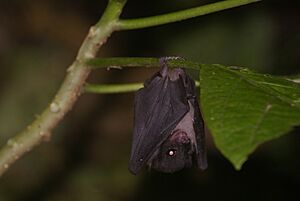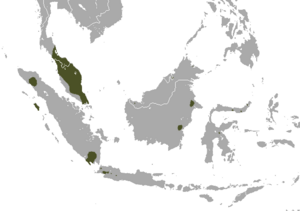Black-capped fruit bat facts for kids
Quick facts for kids Black-capped fruit bat |
|
|---|---|
 |
|
| Conservation status | |
| Scientific classification | |
 |
|
| Black-capped fruit bat range |
The black-capped fruit bat (Chironax melanocephalus) is a type of megabat. It's the only species in its special group, called Chironax. These bats are known for eating fruit, which is how they get their name!
Where Do Black-Capped Fruit Bats Live?
Black-capped fruit bats live in parts of Southeast Asia. They have been found in countries like Thailand, Peninsular Malaysia, Sumatra, Java, and Sulawesi.
In Borneo, they have been seen in places like Sepilok in Sabah and Temburong in Brunei. Scientists have also found them in Sarawak, which is part of Borneo. This includes areas like Kubah National Park, Lambir Hills National Park, and Samunsam Wildlife Sanctuary. Finding them in these spots helped scientists learn more about where these bats live across Borneo.
What Are Black-Capped Fruit Bats Like?
These bats usually live in lowland forests. They prefer places with tall trees, like dipterocarp forests. They have also been found in mixed beach forests near the coast.
Black-capped fruit bats often rest or "roost" in small groups. They like to hang out in tree ferns or inside shallow caves.
Scientists have studied these bats to learn about their lives. They found both male and female adult bats. Some females were pregnant, meaning they were going to have babies. Other females had recently finished feeding their young. This suggests that these bats have babies at different times of the year, depending on the location.


